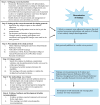What influences the implementation of health checks in the prevention and early detection of chronic diseases among Aboriginal and Torres Strait Islander people in Australian primary health care? Findings from an evidence mapping review
- PMID: 40426191
- PMCID: PMC12107981
- DOI: 10.1186/s12961-025-01325-9
What influences the implementation of health checks in the prevention and early detection of chronic diseases among Aboriginal and Torres Strait Islander people in Australian primary health care? Findings from an evidence mapping review
Abstract
Background: Chronic disease is the leading cause of morbidity and mortality among Aboriginal and Torres Strait Islander peoples in Australia. A comprehensive health assessment is available as an annual health check (HC) to Aboriginal and Torres Strait Islander peoples through the Medicare Benefits Schedule in primary health care settings. This review aims to systematically identify contextual and mechanistic factors that contribute to the success or failure of implementing effective HCs in the prevention and early detection of chronic diseases among Aboriginal and Torres Strait Islander people in Australian primary health care (PHC).
Methods: We systematically searched for peer-reviewed and grey literature, including policy reports, theses, and guidelines, between 1 November 1999 and 30 June 2023, using a combination of keywords and subject headings related to "health checks", "chronic disease", and "Aboriginal and Torres Islander peoples" in seven databases. The extracted data were summarized using a content analysis approach, applying strength-based approaches.
Results: In total, 16 peer-reviewed articles and five grey literature that met the inclusion criteria were used for evidence synthesis that identified several contextual and mechanistic factors that influenced the implementation of HCs. Barriers included resource constraints driven by complexities in administrative, workforce and policy domains that significantly impeded the implementation of HCs. Within PHC, physical space constraints, competing demands and a focus on acute care over preventive measures hindered HC implementation. In addition, inconsistent identification of Aboriginal and Torres Strait Islander status, negative attitudes of PHC staff towards HC efficacy and patients' fear of stigma or confidentiality breaches were barriers. Patients reported HCs as failing to address holistic health needs. To improve HC implementation, enablers included strong clinical leadership, recruitment of culturally competent non-Indigenous and Aboriginal and Torres Strait Islander staff, Indigenous partnership and community engagement and incentives for participation. Effective electronic records, transport provision and flexible scheduling also increased accessibility.
Conclusions: Our findings suggest that future implementation research must adopt a more comprehensive and holistic approach across different models of PHC, with clearly identified contextual and mechanistic factors linked to people-reported and service outcomes, to guide the implementation and evaluation of HCs. While undertaking future research, it is crucial to implement policy and practice reforms as identified in this review to create a culturally safe service at the PHC level required to drive the uptake of quality HCs that aligns with community priorities and aspirations for the prevention and early detection of chronic diseases.
Keywords: Aboriginal and Torres Strait Islander people; Chronic disease; Early detection; Policy and practice; Preventive health; Primary health care.
© 2025. The Author(s).
Conflict of interest statement
Declarations. Ethics approval and consent to participate: Not applicable. Consent for publication: Not applicable. Competing interests: The authors declare no competing interests.
Figures
Similar articles
-
A rapid review to inform the policy and practice for the implementation of chronic disease prevention and management programs for Aboriginal and Torres Strait Islander people in primary care.Health Res Policy Syst. 2024 Mar 21;22(1):34. doi: 10.1186/s12961-024-01121-x. Health Res Policy Syst. 2024. PMID: 38509612 Free PMC article.
-
Understanding the implementation of health checks in the prevention and early detection of chronic diseases among Aboriginal and Torres Strait Islander people in Australia: a realist review protocol.BMJ Open. 2023 Jun 21;13(6):e071234. doi: 10.1136/bmjopen-2022-071234. BMJ Open. 2023. PMID: 37344121 Free PMC article.
-
A qualitative exploration of priorities for quality improvement amongst Aboriginal and Torres Strait Islander primary health care services.BMC Health Serv Res. 2021 May 6;21(1):431. doi: 10.1186/s12913-021-06383-7. BMC Health Serv Res. 2021. PMID: 33957914 Free PMC article.
-
Respect Is Central: A Critical Review of Implementation Frameworks for Continuous Quality Improvement in Aboriginal and Torres Strait Islander Primary Health Care Services.Front Public Health. 2021 Jul 16;9:630611. doi: 10.3389/fpubh.2021.630611. eCollection 2021. Front Public Health. 2021. PMID: 34336752 Free PMC article. Review.
-
Students' experiences of placements in urban indigenous health contexts: developing a culturally responsive workforce.BMC Med Educ. 2024 Dec 18;24(1):1446. doi: 10.1186/s12909-024-06432-9. BMC Med Educ. 2024. PMID: 39696185 Free PMC article.
References
-
- Thurber KA, Brinckley MM, Jones R, Evans O, Nichols K, Priest N, et al. Population-level contribution of interpersonal discrimination to psychological distress among Australian Aboriginal and Torres Strait Islander adults, and to Indigenous-non-Indigenous inequities: cross-sectional analysis of a community-controlled First Nations cohort study. Lancet. 2022;400(10368):2084–94. - PMC - PubMed
-
- Australian Institute of Health and Welfare. Aboriginal and Torres Strait IslanderHealth performance framework 2020 summary report. cat. No. IHPF 2. Canberra: AIHW, 2020.
-
- Australian Institute of Health and Welfare (AIHW). Health checks and follow-ups for Aboriginal and Torres Strait Islander people: Australian Government; 2024. www.aihw.gov.au/reports/indigenous-australians/indigenous-health-checks-.... Accessed 10 Feb 2025.
-
- RACGP NACCHO Aboriginal and Torres Strait Islander Health. Useful high-quality MBS item 715 health checks for Aboriginal and Torres Strait Islander people. 2019.
Publication types
MeSH terms
LinkOut - more resources
Full Text Sources
Miscellaneous




